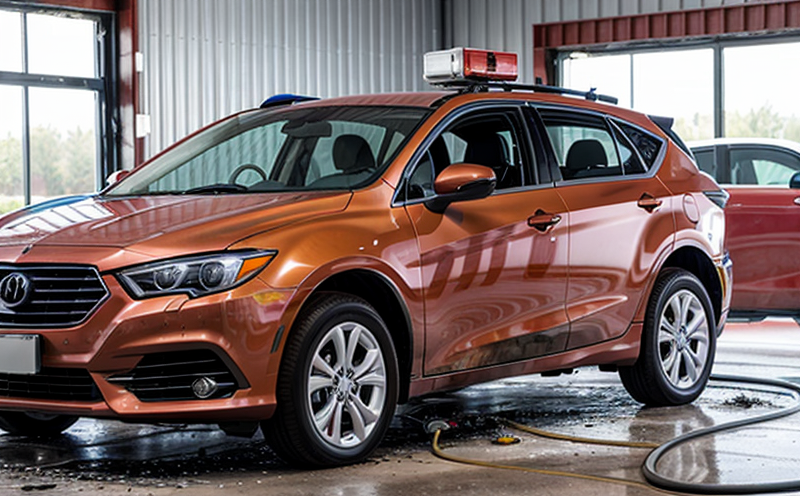Toxic Gas Emission Analysis During Automotive Component Fires
In the automotive sector, fire safety testing is critical to ensuring that vehicle components meet stringent safety and performance standards. One of the most important aspects of this testing involves the analysis of toxic gas emissions during simulated fires. This service focuses on identifying and quantifying potentially harmful gases released from automotive components under extreme conditions.
The purpose of this detailed analysis is twofold: to ensure that component materials do not contribute to the formation of dangerous byproducts in case of a fire, and to assess whether these emissions comply with relevant international standards such as ISO 16951 and EN 458. This service is particularly important for R&D engineers, quality managers, compliance officers, and procurement teams who are responsible for ensuring the safety and sustainability of automotive products.
The process begins with selecting appropriate specimens that represent the materials used in various components such as seats, steering wheels, or interior panels. These samples undergo rigorous testing using advanced instrumentation like Fourier Transform Infrared Spectroscopy (FTIR) and Gas Chromatography-Mass Spectrometry (GC-MS). FTIR helps identify the types of gases produced by breaking down complex organic compounds into simpler ones, while GC-MS provides precise mass measurements to quantify the amounts of each gas emitted.
Once the testing is complete, detailed reports are generated outlining all detected species along with their respective concentrations. Compliance officers can use these findings to ensure that their products meet regulatory requirements set forth by agencies like NHTSA or ECE-R49. For R&D teams, this information serves as valuable input for improving future designs and selecting safer materials.
It is also crucial to note how toxic gas emission analysis plays a role in enhancing overall vehicle safety. By understanding exactly what compounds are released when different parts catch fire, manufacturers can work towards creating more resilient structures capable of containing flames without spreading harmful substances into the surrounding environment. Additionally, this service supports sustainability efforts by minimizing environmental impact through responsible material selection.
In summary, toxic gas emission analysis during automotive component fires is an essential part of ensuring both human safety and ecological well-being within the industry. Through meticulous examination using state-of-the-art equipment, we provide reliable insights that contribute significantly to developing safer vehicles for all users.
Customer Impact and Satisfaction
The implementation of rigorous toxic gas emission analysis services not only enhances product safety but also significantly improves customer satisfaction levels. For quality managers, having access to comprehensive reports allows them to make informed decisions about sourcing materials and manufacturing processes that meet or exceed regulatory expectations.
Compliance officers benefit greatly from this service as it helps verify adherence to strict guidelines provided by various bodies like the National Highway Traffic Safety Administration (NHTSA) in North America, or Euro NCAP for European markets. By ensuring compliance early on in the development cycle, companies can avoid costly recalls later down the line.
R&D engineers gain valuable knowledge about material behavior under extreme conditions which could otherwise be challenging to observe directly. This insight enables them to innovate safer designs that not only pass regulatory tests but also offer superior performance characteristics. Procurement teams appreciate knowing they are working with suppliers who adhere strictly to high standards, thus reducing risks associated with non-compliant parts entering supply chains.
Moreover, satisfied customers form a positive image of the brand among potential buyers, leading to increased trust and loyalty towards the company offering such advanced services. Overall, this service contributes positively across multiple stakeholders involved in automotive manufacturing, making it indispensable for maintaining competitive edge while delivering top-notch products.
International Acceptance and Recognition
The importance of toxic gas emission analysis extends beyond national boundaries; indeed, it enjoys widespread acceptance across numerous countries worldwide. The International Organization for Standardization (ISO) has published specific guidelines in ISO 16951 series which outline methods for determining volatile organic compounds (VOCs), nitrogen oxides (NOx), and other hazardous substances that could be released during a fire incident involving automotive components.
Similarly, European Committee for Standardization (CEN) has developed EN 458 standard providing detailed instructions on conducting tests related to flammability characteristics including toxic gas emissions. These internationally recognized standards serve as benchmarks against which manufacturers test their products ensuring consistency and reliability regardless of geographical location.
Achieving certification according to these accepted protocols not only demonstrates commitment to quality but also opens up market opportunities in multiple regions simultaneously. Companies that embrace such practices are more likely to gain international recognition, thereby enhancing brand reputation globally.
Competitive Advantage and Market Impact
In today’s highly competitive automotive industry, standing out requires not only meeting basic standards but also exceeding them through innovative approaches. By incorporating toxic gas emission analysis into their development processes, manufacturers gain several key advantages:
- Enhanced Safety Profiles: Products that pass rigorous testing are perceived as safer options by consumers, giving companies a significant edge over competitors whose offerings may fail such stringent scrutiny.
- Better Reputation Management: Demonstrating leadership in terms of safety measures fosters goodwill among stakeholders including investors, employees, and public interest groups. Such positive perceptions translate into stronger brand loyalty and enhanced market presence.
- Innovation Facilitation: Continuous improvement efforts driven by robust testing data lead to breakthrough innovations that set new industry benchmarks.
- Regulatory Compliance Assurance: Ensuring strict adherence to global regulations reduces the risk of non-compliance penalties and associated negative publicity. It also helps maintain good relationships with regulatory bodies, which can be crucial during product launches or expansions into new markets.
The ability to consistently deliver superior products backed by comprehensive toxic gas emission analysis will undoubtedly contribute significantly towards establishing a strong competitive position within the automotive sector.





